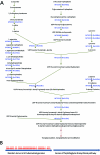Essential metabolites of Mycobacterium tuberculosis and their mimics
- PMID: 21285434
- PMCID: PMC3031304
- DOI: 10.1128/mBio.00301-10
Essential metabolites of Mycobacterium tuberculosis and their mimics
Abstract
An organism requires a range of biomolecules for its growth. By definition, these are essential molecules which constitute the basic metabolic requirements of an organism. A small organic molecule with chemical similarity to that of an essential metabolite may bind to the enzyme that catalyzes its production and inhibit it, likely resulting in the stasis or death of the organism. Here, we report a high-throughput approach for identifying essential metabolites of an organism using genetic and biochemical approaches and then implement computational approaches to identify metabolite mimics. We generated and genotyped 5,126 Mycobacterium tuberculosis mutants and performed a statistical analysis to determine putative essential genes. The essential molecules of M. tuberculosis were classified as products of enzymes that are encoded by genes in this list. Although incomplete, as many enzymes of M. tuberculosis have yet to be identified and characterized, this is the first report of a large number of essential molecules of the organism. We identified essential metabolites of three distinct metabolic pathways in M. tuberculosis and selected molecules with chemical similarity using cheminformatics strategies that illustrate a variety of different pharmacophores. Our approach is aimed at systematic identification of essential molecules and their mimics as a blueprint for development of effective chemical probes of M. tuberculosis metabolism, with the ultimate goal of seeking drugs that can kill this pathogen. As an illustration of this approach, we report that compounds JFD01307SC and l-methionine-S-sulfoximine, which share chemical similarity with an essential molecule of M. tuberculosis, inhibited the growth of this organism at micromolar concentrations.
Copyright © 2011 Lamichhane et al.
Figures


References
-
- WHO 2009. Global tuberculosis control, p. 4–5 WHO, Geneva, Switzerland
-
- Corbett E. L., Watt C. J., Walker N., Maher D., Williams B. G., Raviglione M. C., Dye C. 2003. The growing burden of tuberculosis: global trends and interactions with the HIV epidemic. Arch. Intern. Med. 163:1009–1021 - PubMed
-
- Dye C., Scheele S., Dolin P., Pathania V., Raviglione M. C. 1999. Consensus statement. Global burden of tuberculosis: estimated incidence, prevalence, and mortality by country. WHO Global Surveillance and Monitoring Project. JAMA 282:677–686 - PubMed
-
- Fauci A. S. 2008. Multidrug-resistant and extensively drug-resistant tuberculosis: the National Institute of Allergy and Infectious Diseases Research agenda and recommendations for priority research. J. Infect. Dis. 197:1493–1498 - PubMed
-
- Jassal M., Bishai W. R. 2009. Extensively drug-resistant tuberculosis. Lancet Infect. Dis. 9:19–30 - PubMed
Publication types
MeSH terms
Substances
Grants and funding
LinkOut - more resources
Full Text Sources
Other Literature Sources
Research Materials
